Digital Twin Design of a Turbulence Inhibitor in a Tundish Based on the Production Cluster Mining Algorithm
Abstract
1. Introduction
2. Simulation of Flow Field
2.1. Simulation
- For inclusions, the inlet is set as injection, the particles are uniformly arranged, and the inlet speed of the particles is the same as that of liquid steel.
- The normal velocity and gradient of the free liquid surface are zero. For inclusions, the trap boundary is set. When the inclusions collide with the free liquid surface, they are adsorbed, and the wall surface is set as the non-slip boundary. When the inclusions collide directly with the wall and the velocity is no less than 0.01 m/s, the particles will be directly removed from the calculation domain and the calculation trajectory will be terminated; otherwise, the particles will be reflected by the wall.
- The water outlet of the tundish is the pressure outlet. For inclusions, the escape boundary is set. When the inclusions reach the lower outlet of the calculation domain, they escape from the outlet.
2.2. Flow Field Data Analysis
3. Algorithm
3.1. The Database
3.2. Algorithm Framework for Production Clustering Mining
3.2.1. Establishment of the Temporary Library, Reading, and Diversified Output of
- Reading the number of rows, columns, row values, and column values in the data table.
- Reading the value and data type of the data.
- Adding, deleting, and modifying table data.
3.2.2. Set Aggregation with the BFS Algorithm [25]
- Provide a connected graph and initialize it all in white (not visited), as shown in Figure 4a;
- The search starting point V1 (gray) is shown in Figure 4b;
- V1 (black) has been searched, and V2, V3, and V4 (grayed out) are about to be searched, as shown in Figure 4c;
- Repeat the above operation for V2, V3, and V4 until V7 is found, as shown in Figure 4d.
3.2.3. Utilizing a Production Mining Algorithm to Extract Feature Flow Field Information in the Inclusion Aggregation Zone
- Proposed Assumptions:
- 2.
- The inspection level is determined (α = 0.05).
- 3.
- The t-value is calculated.
- 4.
- When the two sets of variances are homogeneous, the Student’s t-method can be used:
- 5.
- When the variance is heterogeneous, the Welch t-test method is used, and the formula for calculating the t-value is the following:
- 6.
- The boundary value table is checked to determine the p-value; the boundary value table is determined according to degrees of freedom () and inspection level (α).
- 7.
- If the calculated t-value is less than the critical value p at the α level, this indicates that p > α at the t value. Therefore, at the α level, the original hypothesis should be accepted and the alternative hypothesis should be rejected, and vice versa.
4. Analysis
4.1. Analysis Objects
4.2. Characteristic Parameters in the Inclusion Aggregation Zone in the Tundish Impact Zone
4.3. Flow Field Characteristic Parameters in the Inclusion Aggregation Zone Outside the Impact Zone
4.4. Pseudo-Code for Screening the Inclusion Aggregation Zone Location
| Algorithm 1: Occluded foreign substance aggregation area selection; digital twin algorithm for inclusions aggregation area in the tundish |
| Input: Coordinate Axis X, Y, Z; Parcel_Diameter Pdi; Occluded foreign substance Nodei; Overall Occluded foreign substance data The whole data; Output: Occluded foreign substance aggregation area gather_area
|
5. Water Model Experiment
6. Digital Twin Design of the Turbulence Inhibitor
7. Conclusions
- (1)
- The flow field in the inclusion aggregation zone in the tundish impact zone is characterized by high pressure, high speed, high turbulence kinetic energy, and high vorticity, and it is located in the area above the inhibitor where the median flow velocity is 0.618 m/s with a deviation range of ±0.307 m/s and the median vorticity is 10.25 m2/s2, with a deviation range of ±0.883 m2/s2.
- (2)
- The flow field in the inclusion aggregation zone outside the tundish impact zone is characterized by high pressure and low vorticity at the vortex center of the flow field, where the median pressure of the flow field is 82,525 Pa and the deviation range is ±7.85 Pa.
- (3)
- According to the results of algorithm mining, a pseudo-code was designed to screen the inclusion aggregation zone in the tundish.
- (4)
- Based on the digital twin method, the design of an inner-swirling turbulence inhibitor was optimized through combining data mining and water model experimental data results, resulting in a 14.4% increase in the removal rate of inclusions at the outlet of the water model.
Author Contributions
Funding
Data Availability Statement
Conflicts of Interest
References
- Yazdi, M.R.M.; Khorasani, A.R.F.; Talebi, S. Experimental Investigation of Flow Control Devices Effect on Inclusion Separation in a Four Strand Tundish. Can. Metall. Q. 2019, 58, 379–388. [Google Scholar] [CrossRef]
- Zheng, S.G.; Zhu, M.Y. Optimization of Flow Control Devices in a Ten-Strand Billet Caster Tundish. China Foundry 2016, 13, 414–421. [Google Scholar] [CrossRef][Green Version]
- Santos, G.G.; Antônio, D.S.C.; Fernandes, R.R.; Seara, M.R.; Varadarajan, S.; Mol, P.J.J. Inclusion Removal Studies in a Two-Strand Tundish: Effect of Substitution of Turbulence Inhibitor with Dams and Effect of Teeming Ladle and Ladle Shroud Set Asymmetry Employing Physical and Mathematical Modeling. Trans. Indian Inst. Met. 2023, 76, 1853–1861. [Google Scholar]
- Cheng, G.J.; Lei, H.; Geng, X.Q.; Han, D.; Chen, J.; He, Y.C. Influence of Turbulence Inhibitor on Removal Rate of Inclusion in a Special-Shaped Continuous Casting Tundish. Steelmaking 2010, 26, 51–54. [Google Scholar]
- Deng, A.Y.; He, Y.C.; Jia, G.L. Trajectories of Inclusions during Solidification of Steel Square Billet. J. Northeast. Univ. 2000, 21, 532–535. [Google Scholar]
- Liu, Z.Y.; Jin, Y.; Gan, F.F.; Lin, P.; Huang, J.Y.; Li, J. Analysis of Optimization Weights for Flow Field of Internal Rotation Stabilizer Coupled with Porous Retaining Wall. Metals 2021, 11, 1208. [Google Scholar] [CrossRef]
- Li, J.; Lu, J.L.; Luo, Z.G.; Zhou, Z.S. Numerical Simulation of Inclusion Removal in Tundish with Gas Curtain. Steelmaking 2023, 39, 52–57. [Google Scholar]
- Cupek, J.; Tkadlecková, M.; Merder, T.; Walek, J.; Saternus, M.; Pieprzyca, J. Computational fluid dynamics (CFD) analysis of medium flow and removal of inclusions in a two-strand tundish. Metalurgija 2023, 63, 3–4. [Google Scholar]
- Tomasz, M.; Jacek, P.; Marek, W.; Piotr, W.; Aryur, H. Evolution of the Numerical Model Describing the Distribution of Non-Metallic Inclusions in the Tundish. Materials 2021, 14, 9. [Google Scholar]
- Dandekar, R.; Rajesh, R.; Subashri, V.; Zaboronski, O. A Monte Carlo Algorithm to Measure Probabilities of Rare Events in Cluster-Cluster Aggregation. Comput. Phys. Commun. 2023, 288, 108727. [Google Scholar] [CrossRef]
- Zhang, B.W.; Deng, K.; Lei, Z.S.; Ren, Z.M. A Mathematical Model on Coalescence and Removal of Inclusion Particles in Continuous Casting Tundish. Acta Metall. Sin. 2004, 40, 623. [Google Scholar]
- Yang, M.L.; Cheng, C.G.; Li, Y.; Lu, H.B.; Zhou, Y.; Jin, Y. Development of Control Technology and Clogging Mechanism for Tundish Nozzle in Continuous Casting. J. Iron Steel Res. 2017, 29, 773–780. [Google Scholar]
- Lei, H.; He, J. Numerical Simulation for Collision and Aggregation of Inclusions in a Slab Continuous Caster. Steel Res. Int. 2016, 78, 659–728. [Google Scholar] [CrossRef]
- Lo, C.K.; Chen, C.H.; Zhong, R.Y. A Review of Digital Twin in Product Design and Development. Adv. Eng. Inform. 2021, 48, 101297. [Google Scholar] [CrossRef]
- Barricelli, B.R.; Casiraghi, E.; Fogli, D. A Survey on Digital Twin: Definitions, Characteristics, Applications, and Design Implications. IEEE Access 2019, 7, 167653–167671. [Google Scholar] [CrossRef]
- Liu, M.N.; Fang, S.L.; Dong, H.Y.; Xu, C.Z. Review of Digital Twin about Concepts, Technologies, and Industrial Applications. J. Manuf. Syst. 2021, 58, 346–361. [Google Scholar] [CrossRef]
- Tarek, M.; Faroogh, G.; Tew-Fik, M. Numerical Modeling of Liquid Spills From the Damaged Container and Collision of Two Rising Bubbles in Partially Filled Enclosure Using Modified Volume-of-Fluid (VOF) Method. Eng. Anal. Bound. Elem. 2023, 154, 83–121. [Google Scholar]
- Zhang, H.; Fang, Q.; Deng, S.Y.; Liu, C.; Ni, H.W. Multiphase Flow in a Five-Strand Tundish Using Trumpet Ladle Shroud during Steady-State Casting and Ladle Change-Over. Steel Res. Int. 2019, 90, 1800497. [Google Scholar] [CrossRef]
- Tkadlečková, M.; Walek, J.; Michalek, K.; Huczal, T. Numerical Analysis of RTD Curves and Inclusions Removal in a Multi-Strand Asymmetric Tundish with Different Configuration of Impact Pad. Metals 2020, 10, 849. [Google Scholar] [CrossRef]
- Zhu, M.M.; Peng, S.K.; Jiang, K.C.; Luo, J.; Zhong, Y.; Tang, P. Fluid Flow and Heat Transfer Behaviors under Non-Isothermal Conditions in a Four-Strand Tundish. Metals 2022, 12, 840. [Google Scholar] [CrossRef]
- Gupta, K.V.; Pradeep, K.J.; Pramod, K.J. Numerical Investigation on Gas Bubbling Assisted Inclusion Transport and Removal in Multistrand Tundish. Met. Mater. Int. 2022, 28, 2146–2165. [Google Scholar] [CrossRef]
- Holzinger, G.; Thumfart, M. Flow Interaction in Continuous Casting Tundish Due to Bubble Curtain Operation. Steel Res. Int. 2019, 90, 1800642. [Google Scholar] [CrossRef]
- Wang, Q.; Liu, Y.; Huang, A.; Yan, W.; Gu, H.Z.; Li, G.Q. CFD Investigation of Effect of Multi-hole Ceramic Filter on Inclusion Removal in a Two-Strand Tundish. Metall. Mater. Trans. 2020, 51, 276–292. [Google Scholar] [CrossRef]
- Barrett, P.; Hunter, J.; Miller, J.T.; Hsu, J.-C.; Greenfield, P. Matplotlib--A Portable Python Plotting Package. In Astronomical Data Analysis Software and Systems XIV ASP Conference Series, Proceedings of the XIV ASP Conference, Pasadena, CA, USA, 24–27 October 2004; Astronomical Society of the Pacific: San Francisco, CA, USA, 2005; Volume 347, pp. 24–27. [Google Scholar]
- Tahlyan, D.; Pinjari, A.R. Performance Evaluation of Choice Set Generation Algorithms for Analyzing Truck Route Choice: Insights from Spatial Aggregation for the Breadth First Search Link Elimination (BFS-LE) Algorithm. Transp. A: Transp. Sci. 2020, 16, 1030–1061. [Google Scholar] [CrossRef]
- Jasika, N.; ALispahic, N.; Elma, A.; Ilvana, K.; Elma, L.; Nosovic, N. Dijkstra’s Shortest Path Algorithm Serial and Parallel Execution Performance Analysis. In Proceedings of the IEEE 35th International Convention MIPRO 2012, Opatija, Croatia, 21–25 May 2012; pp. 1811–1815. [Google Scholar]
- Martel, C. The Expected Complexity of Prim’s Minimum Spanning Tree Algorithm. Inf. Process. Lett. 2002, 81, 197–201. [Google Scholar] [CrossRef]
- Kyun, K.T. T test as a parametric statistic. Korean J. Anesthesiol. 2015, 68, 540–546. [Google Scholar]
- Posten, H.O. The Robustness of the One-Sample t-Test Over the Pearson System. J. Stat. Comput. Simul. 1979, 9, 133–149. [Google Scholar] [CrossRef]
- Schober, P.; Vetter, T.R. Two-Sample Unpaired t Tests in Medical Research. Anesth. Analg. 2019, 129, 911. [Google Scholar] [CrossRef]
- Xu, M.F.; Fralick, D.; Zheng, J.Z.; Wang, B.K.; Tu, X.M.; Feng, C.Y. The Differences and Similarities Between Two-Sample t-Test and Paired t-Test. Shanghai Arch. Psychiatry 2017, 29, 184–188. [Google Scholar]
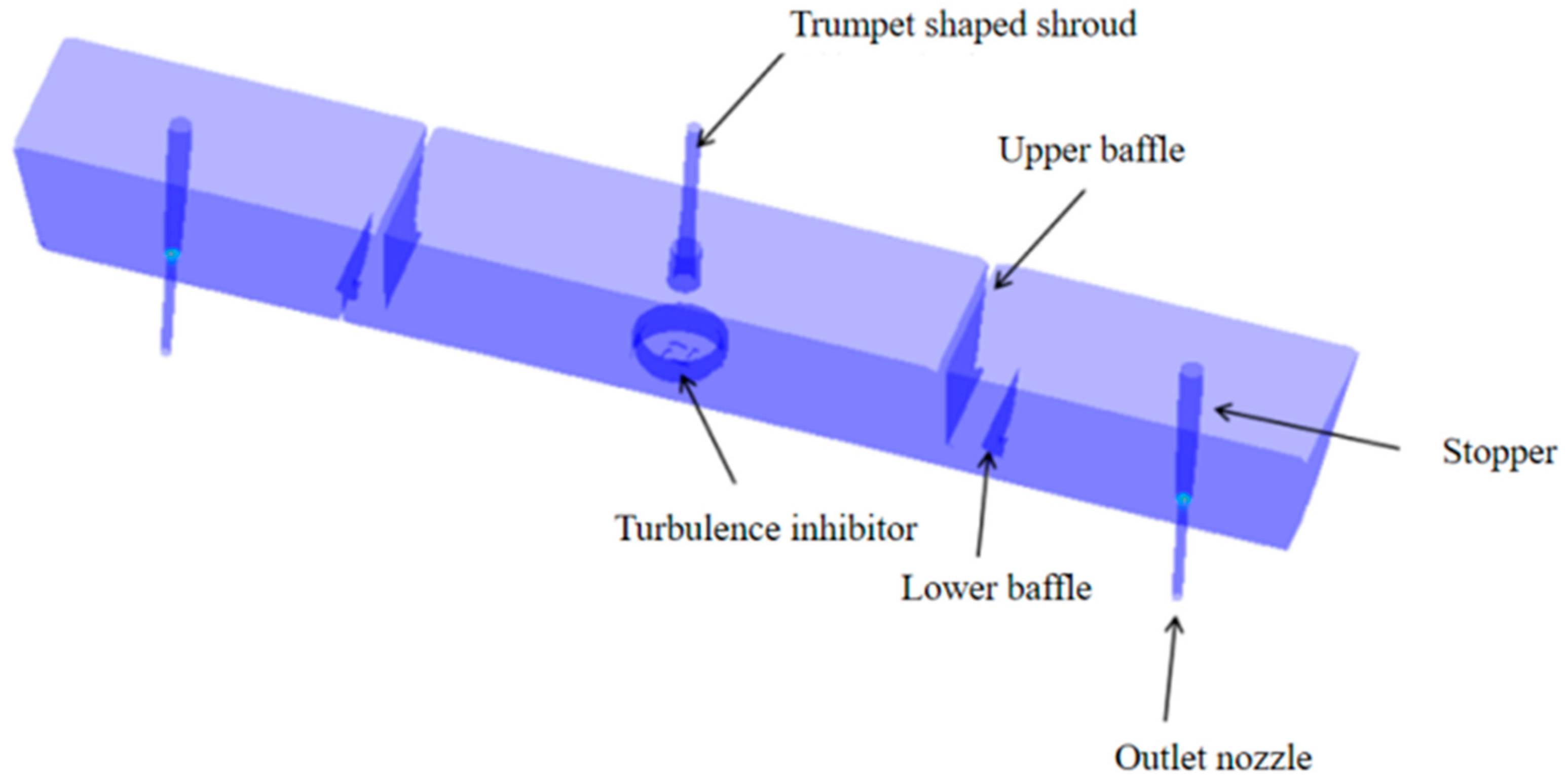

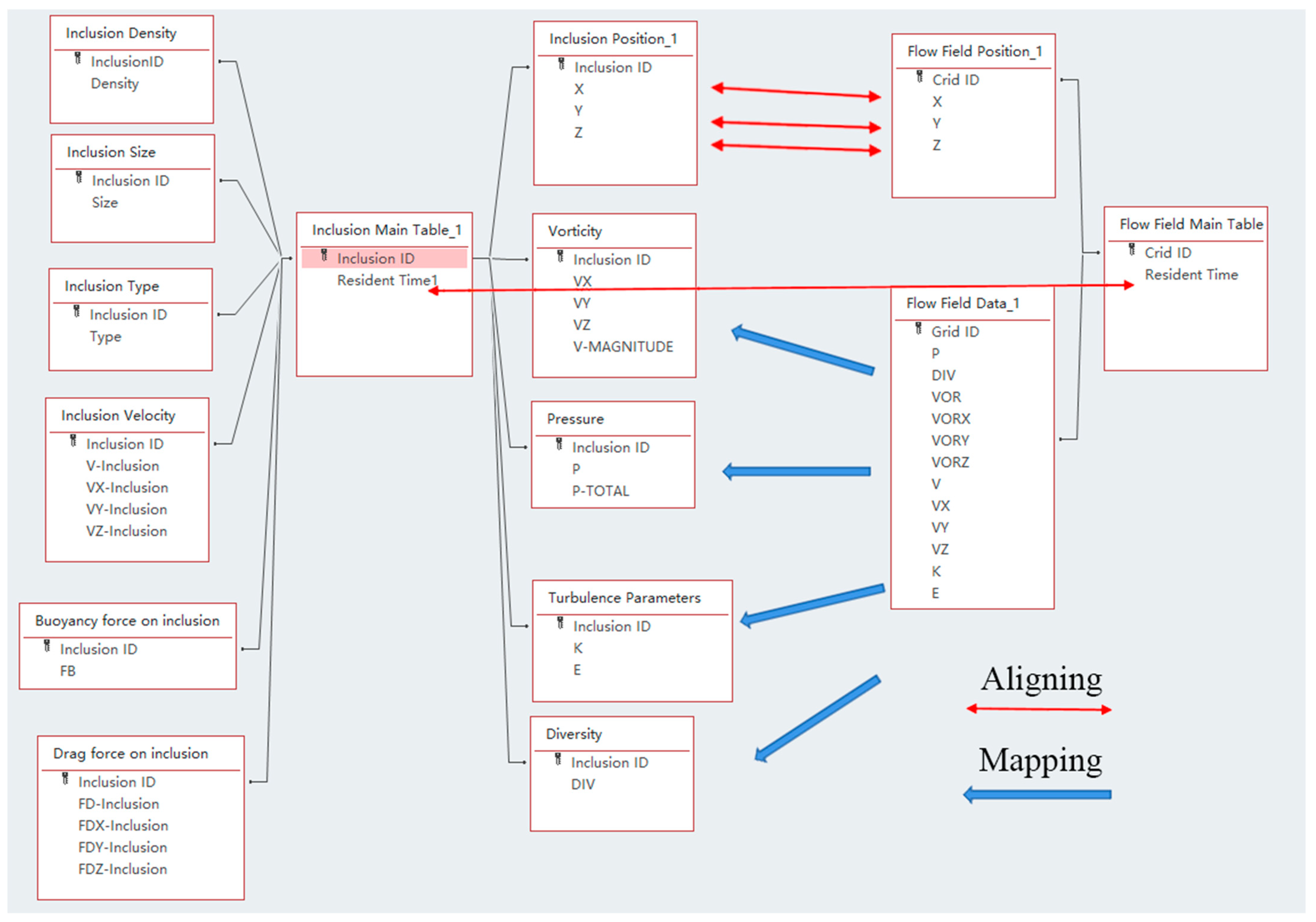
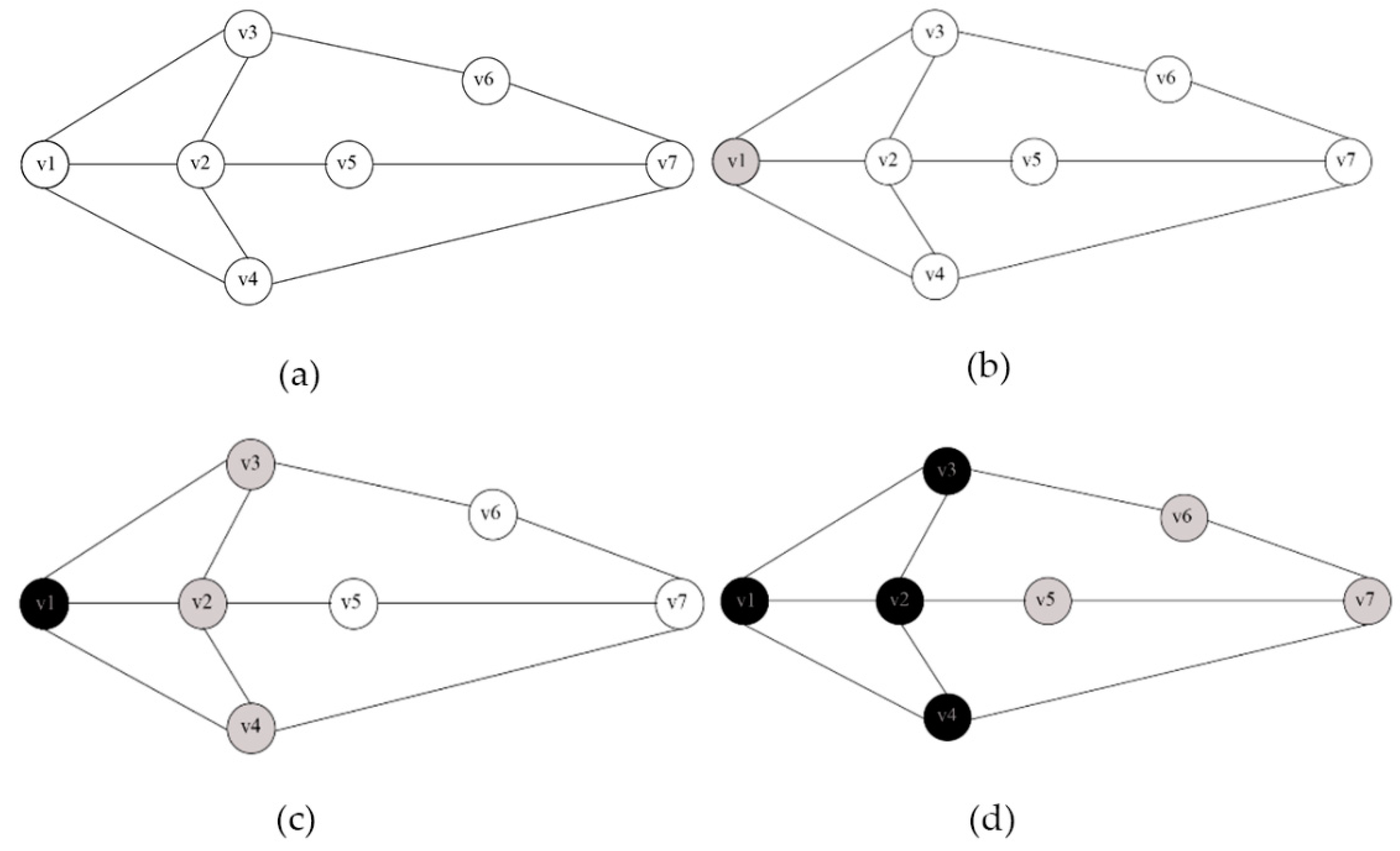



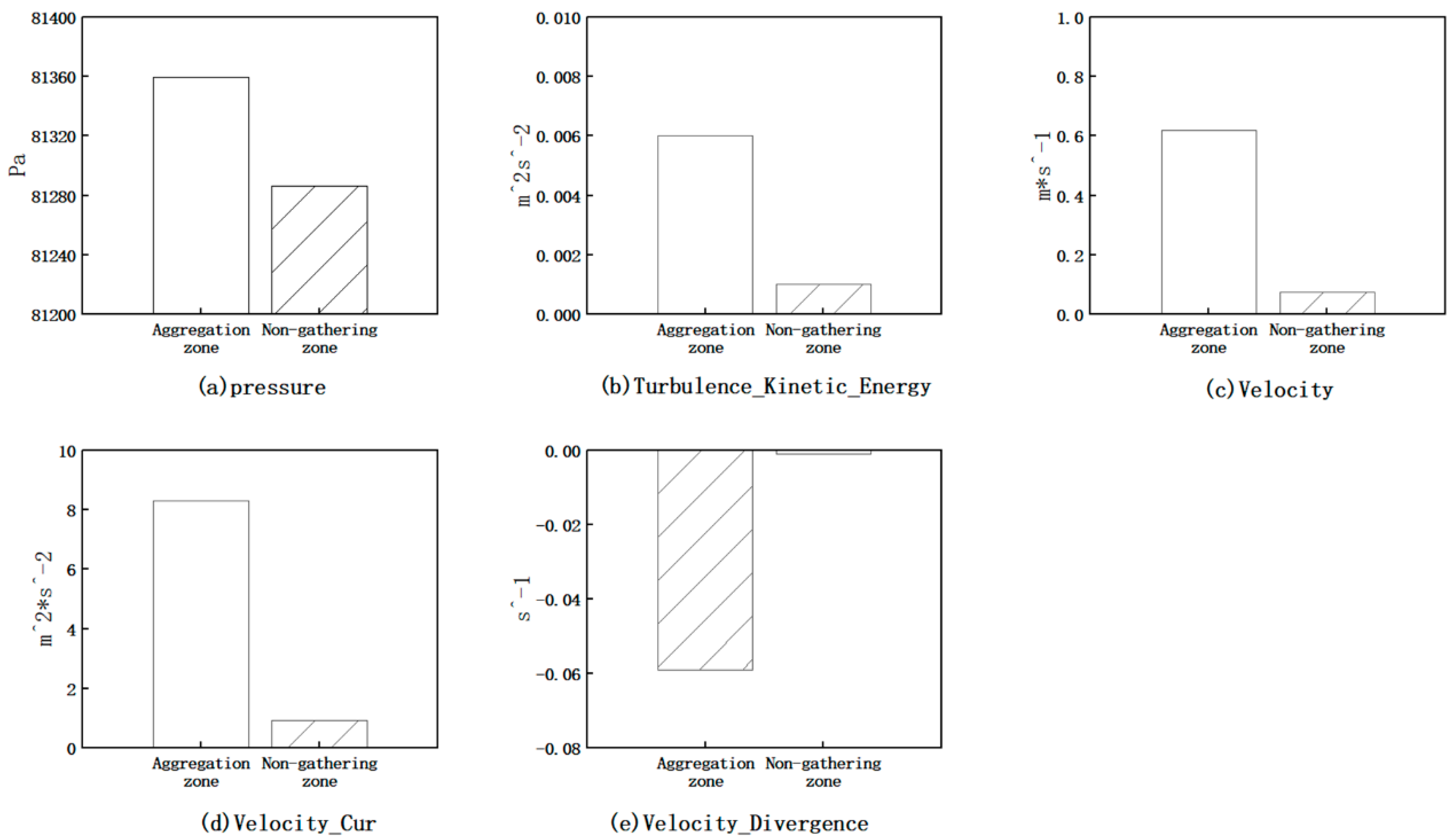



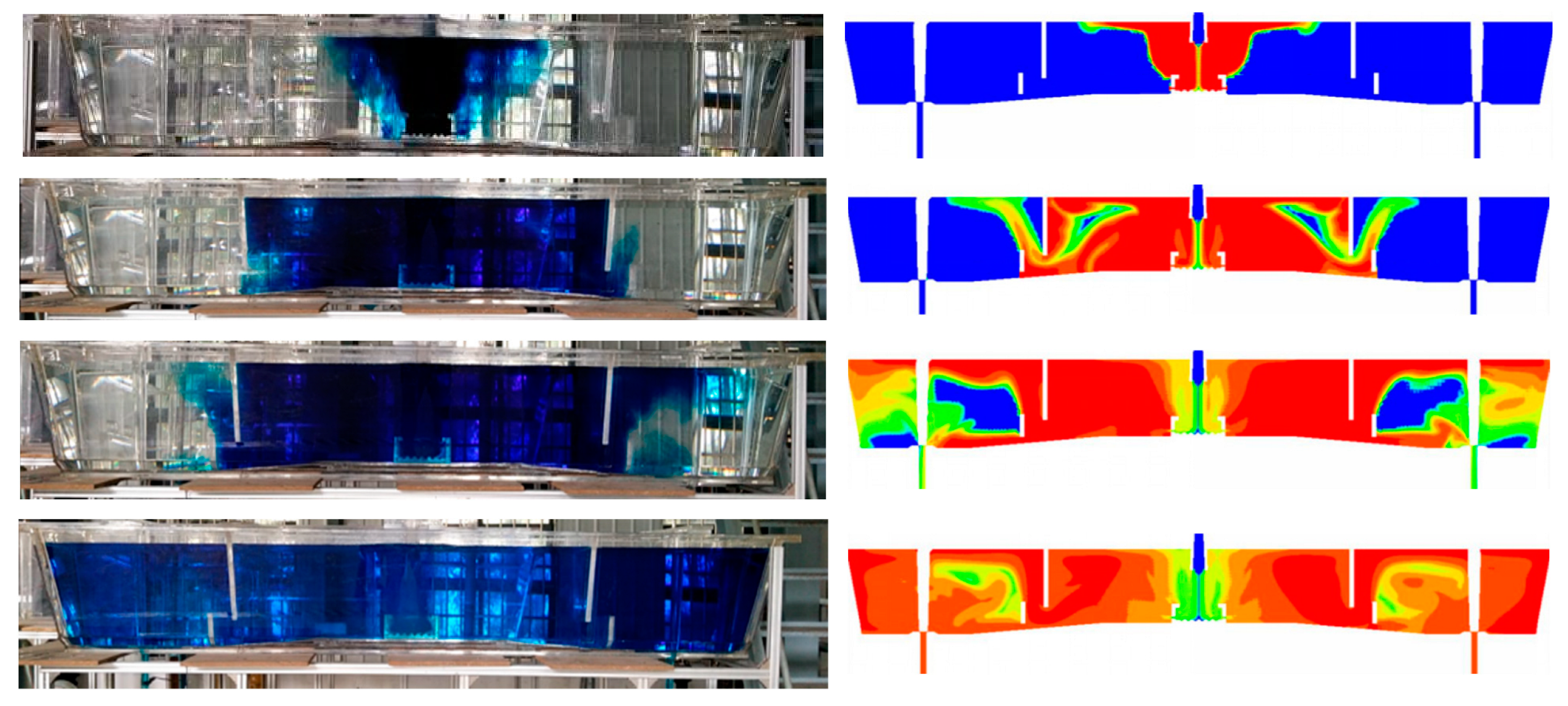


| Parameters | Value | Parameters | Value |
|---|---|---|---|
| The top length of tundish/mm | 9000 | Submerged depth of shroud/mm | 300 |
| The bottom length of tundish/mm | 8800 | Inner diameter of shroud (upper opening)/mm | 105 |
| The top width of tundish/mm | 1200 | External diameter of shroud (lower opening)/mm | 235 |
| Operation depth of molten steel/mm | 1100 | Inner diameter of outlet nozzles/mm | 80 |
| Experimental Group Number | Diameter of Diversion Hole (mm) | Diversion Pier Height (mm) | Diversion Pier Position (mm) | Outer Diameter of Turbulence (mm) |
|---|---|---|---|---|
| 1 | 97 | 30 | 90 | 370 |
| 2 | 107 | 60 | 110 | 390 |
| 3 | 117 | 90 | 130 | 410 |
| Shape of Guide Holes | Diameter (mm) | Width (mm) | Area (m2) | Hole Angle (°) |
|---|---|---|---|---|
| Long circular | 50 | 57 | 0.0089 | 59 |
| Parameters Checked | Pressure | Turbulence Kinetic Energy | Velocity | Velocity Cur | Velocity Divergence |
|---|---|---|---|---|---|
| p | 0.00273 | 6.322 × 10−9 | 4.01 × 10−7 | 2.93 × 10−9 | 0.166 |
| Cohen’s d value | 1.069 | 4.827 | 6.628 | 5.101 | 0.322 |
| Mean (inclusion aggregation zone) | 81,359 | 0.006 | 0.618 | 8.304 | −0.059 |
| Std (inclusion aggregation zone) | 92 | 0.002 | 0.307 | 3.01 s | 0.136 |
| Parameters Checked | Pressure | Turbulence Kinetic Energy | Velocity Cur | Velocity Divergence |
|---|---|---|---|---|
| p | 0.32 | 0.076 | 0.036 | 0.923 |
| Cohen’s d value | 0.425 | 0.779 | 0.933 | 0.041 |
| Mean (inclusion aggregation zone) | 81,332 | 0.007 | 10.25 | −0.012 |
| Std (inclusion aggregation zone) | 89 | 0.002 | 0.883 | 0.083 |
| Parameters Checked | Pressure | Turbulence Kinetic Energy | Velocity | Velocity Cur | Velocity Divergence |
|---|---|---|---|---|---|
| p | 0.019 | 0.650 | 0.955 | 0.975 | 0.725 |
| Cohen’s d value | 0.964 | 0.186 | 0.023 | 0.013 | 0.144 |
| Mean (inclusion aggregation zone) | 82,525 | 0.000 18 | 0.044 | 0.507 | 0.005 |
| Std (inclusion aggregation zone) | 7.85 | 0.000055 | 0.007 | 0.215 | 0.01 |
| Parameter | Prototype Tundish | Model Tundish |
|---|---|---|
| Total length of inner top and bottom of tundish (mm) | 9300\8823 | 3100\2941 |
| Maximum width of inner top surface (mm) | 1304 | 435 |
| Depth of liquid level (mm) | 1200 | 400 |
| Inside diameter and outside diameter of the top of the long nozzle (mm) | 105\185 | 35\62 |
| Long nozzle insertion depth (mm) | 300 | 100 |
| Inner diameter of water outlet (mm) | 80 | 27 |
| Diversion pier thickness (mm) | 60 | 20 |
| Plug diameter at liquid level (mm) | 162 | 54 |
| Guide Hole Shape | Width (mm) | Area (m2) | Guide Hole Angle (°) |
|---|---|---|---|
| Long circular | 62 | 0.0109 | 46 |
Disclaimer/Publisher’s Note: The statements, opinions and data contained in all publications are solely those of the individual author(s) and contributor(s) and not of MDPI and/or the editor(s). MDPI and/or the editor(s) disclaim responsibility for any injury to people or property resulting from any ideas, methods, instructions or products referred to in the content. |
© 2023 by the authors. Licensee MDPI, Basel, Switzerland. This article is an open access article distributed under the terms and conditions of the Creative Commons Attribution (CC BY) license (https://creativecommons.org/licenses/by/4.0/).
Share and Cite
Wu, J.; Jin, Y.; Gan, F.; Li, X.; Liu, Z.; Lin, P.; Huang, Z.; Ling, H. Digital Twin Design of a Turbulence Inhibitor in a Tundish Based on the Production Cluster Mining Algorithm. Metals 2023, 13, 1651. https://doi.org/10.3390/met13101651
Wu J, Jin Y, Gan F, Li X, Liu Z, Lin P, Huang Z, Ling H. Digital Twin Design of a Turbulence Inhibitor in a Tundish Based on the Production Cluster Mining Algorithm. Metals. 2023; 13(10):1651. https://doi.org/10.3390/met13101651
Chicago/Turabian StyleWu, Jianzhou, Yan Jin, Feifang Gan, Xiaoting Li, Ziyu Liu, Peng Lin, Zhengchao Huang, and Hongzhi Ling. 2023. "Digital Twin Design of a Turbulence Inhibitor in a Tundish Based on the Production Cluster Mining Algorithm" Metals 13, no. 10: 1651. https://doi.org/10.3390/met13101651
APA StyleWu, J., Jin, Y., Gan, F., Li, X., Liu, Z., Lin, P., Huang, Z., & Ling, H. (2023). Digital Twin Design of a Turbulence Inhibitor in a Tundish Based on the Production Cluster Mining Algorithm. Metals, 13(10), 1651. https://doi.org/10.3390/met13101651






